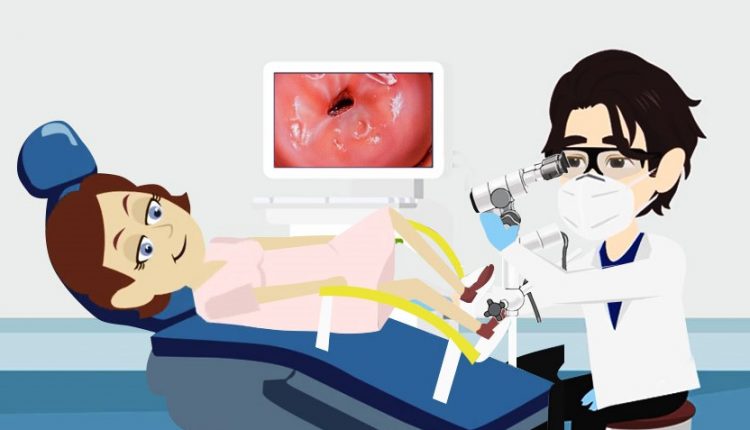
Colposcopy: what is it?
Colposcopy came into being thanks to Hans Hinselmann in 1921 who, a professor extraordinaire at the University of Hamburg, began his studies to better observe the portio (cervix) by developing the first, rudimentary, but functional colposcope
What is colposcopy?
Colposcopy consists of a thorough test of the cervix through the colposcope.
The cervix or cervix is the lower part of the uterus and is located at the top of the vagina.
What is the difference between a Pap test and colposcopy?
When the gynaecologist performs the Pap test, he or she sees the cervix, but cannot observe it accurately.
The colposcope, on the other hand, allows us colposcopists a more detailed view: we insert the speculum as with the Pap test, but the colposcope does not enter the vagina, remaining at leg level.
The pap smear ‘identifies’, the colposcopy ‘localises’.
Cytology (pap smear) is the first step (1st level) of cervicocarcinoma prevention, colposcopy is the second level method, which identifies the lesion and allows indications for targeted treatment to be set.
When should colposcopy be performed?
Patients referred to the colposcopy outpatient clinic are those in whom the Pap test has shown:
- Abnormal cells.
- Diagnosis of viral infections.
- Control of CIN in pregnancy.
- Diagnosis of vulvar pathology (vulvoscopy).
- Diagnosis of penile pathology (peniscopy).
The endocervical and cervicovaginal cytological sampling (Pap test) must be performed in a woman in the intermenstrual phase, on a clean neck, with transparent mucus to allow an accurate map of the lesions to be made: for this, it is necessary not to have had, in the previous 24 hours, sexual intercourse or to have had vaginal douches and/or intravaginal therapy (ovules, vaginal gels, etc.).
How does colposcopy take place?
A colposcopy takes 15 to 20 minutes.
Anaesthesia is not necessary and the woman can follow the entire test.
At the beginning of the test, the gynaecologist will take a Pap test sample, then look at the cervix through the colposcope.
This does not cause any discomfort or pain.
In order to see the abnormal epithelium, the gynaecologist will apply certain liquids:
- The first is acetic acid (a weak acid that can sometimes burn slightly).
- Next, a dark liquid (Lugol’s solution) will be applied.
- Sometimes it may be necessary to take a fragment of abnormal epithelium in order to perform a more accurate histological investigation: this is the biopsy.
Once the colposcopic test has been completed with any cytological or biopsy samples, the doctor completes the colposcopic file with a graphic representation of the lesion, its site and extent, and an indication of where the biopsy was taken.
In the context of HPV viral infections, colposcopy also allows a careful test of the genital tract (vagina, vulva, perineum).
At the same time, a peniscopy is desired in the partner in search of HPV infection (found in 40-60% of partners, leading to recurrences if unknown).
The patient’s treatment is then decided on the basis of the colposcopic findings and biopsy results.
Notes
In Italy in 1940 Cattaneo had Hinselmann’s text Einfuhrung in die Kolposcopie translated under the title ‘Introduction to Colposcopy’.
It was not until the 1970s that colposcopy was accepted as a second level diagnostic means after abnormal cytological tests (Paptest), as a means that allowed a targeted biopsy, and as a means that excluded the need for conization traditionally used on cytological indication.
Read Also
Emergency Live Even More…Live: Download The New Free App Of Your Newspaper For IOS And Android
Colposcopy: How To Prepare, How It Is Performed, When It Is Important
Breast Cancer: For Every Woman And Every Age, The Right Prevention
Transvaginal Ultrasound: How It Works And Why It Is Important
Pap Test, Or Pap Smear: What It Is And When To Do It
Mammography: A “Life-Saving” Examination: What Is It?
Breast Cancer: Oncoplasty And New Surgical Techniques
Gynaecological Cancers: What To Know To Prevent Them
Ovarian Cancer: Symptoms, Causes And Treatment
What Is Digital Mammography And What Advantages It Has
What Are The Risk Factors For Breast Cancer?
Breast Cancer Women ‘Not Offered Fertility Advice’
Abnormal Uterine Bleeding: Causes And Tests To Be Performed
How Does Cystitis Manifest Itself?
Cystitis, Antibiotics Are Not Always Necessary: We Discover Non-Antibiotic Prophylaxis
Vulvodynia: What Are The Symptoms And How To Treat It
What Is Vulvodynia? Symptoms, Diagnosis And Treatment: Talk To The Expert
Accumulation Of Fluid In The Peritoneal Cavity: Possible Causes And Symptoms Of Ascites
What’s Causing Your Abdominal Pain And How To Treat It
Pelvic Varicocele: What It Is And How To Recognise The Symptoms
Can Endometriosis Cause Infertility?
Transvaginal Ultrasound: How It Works And Why It Is Important
Candida Albicans And Other Forms Of Vaginitis: Symptoms, Causes And Treatment
What Is Vulvovaginitis? Symptoms, Diagnosis And Treatment
Vaginal Infections: What Are The Symptoms?
Chlamydia: What Are The Symptoms And How To Treat It
Chlamydia, Symptoms And Prevention Of A Silent And Dangerous Infection
Spotting, Or Atypical Female Bleeding: What It Is And The Diagnostic Pathway
What Are The Symptoms Of Urethritis And How Is It Treated?



